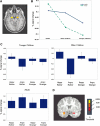The changing face of emotion: age-related patterns of amygdala activation to salient faces
- PMID: 20194512
- PMCID: PMC3023079
- DOI: 10.1093/scan/nsq007
The changing face of emotion: age-related patterns of amygdala activation to salient faces
Abstract
The present study investigated age-related differences in the amygdala and other nodes of face-processing networks in response to facial expression and familiarity. fMRI data were analyzed from 31 children (3.5-8.5 years) and 14 young adults (18-33 years) who viewed pictures of familiar (mothers) and unfamiliar emotional faces. Results showed that amygdala activation for faces over a scrambled image baseline increased with age. Children, but not adults, showed greater amygdala activation to happy than angry faces; in addition, amygdala activation for angry faces increased with age. In keeping with growing evidence of a positivity bias in young children, our data suggest that children find happy faces to be more salient or meaningful than angry faces. Both children and adults showed preferential activation to mothers' over strangers' faces in a region of rostral anterior cingulate cortex associated with self-evaluation, suggesting that some nodes in frontal evaluative networks are active early in development. This study presents novel data on neural correlates of face processing in childhood and indicates that preferential amygdala activation for emotional expressions changes with age.
Figures



Similar articles
-
Age-related changes in amygdala-frontal connectivity during emotional face processing from childhood into young adulthood.Hum Brain Mapp. 2016 May;37(5):1684-95. doi: 10.1002/hbm.23129. Epub 2016 Mar 2. Hum Brain Mapp. 2016. PMID: 26931629 Free PMC article.
-
Children's processing of emotions expressed by peers and adults: an fMRI study.Soc Neurosci. 2010;5(5-6):543-59. doi: 10.1080/17470911003708206. Soc Neurosci. 2010. PMID: 20486013
-
Functional brain activation to emotional and nonemotional faces in healthy children: evidence for developmentally undifferentiated amygdala function during the school-age period.Cogn Affect Behav Neurosci. 2013 Dec;13(4):771-89. doi: 10.3758/s13415-013-0167-5. Cogn Affect Behav Neurosci. 2013. PMID: 23636982 Free PMC article.
-
Functional atlas of emotional faces processing: a voxel-based meta-analysis of 105 functional magnetic resonance imaging studies.J Psychiatry Neurosci. 2009 Nov;34(6):418-32. J Psychiatry Neurosci. 2009. PMID: 19949718 Free PMC article. Review.
-
Getting to Know Someone: Familiarity, Person Recognition, and Identification in the Human Brain.J Cogn Neurosci. 2020 Dec;32(12):2205-2225. doi: 10.1162/jocn_a_01627. Epub 2020 Sep 9. J Cogn Neurosci. 2020. PMID: 32902334 Review.
Cited by
-
Distinctive effects of fear and sadness induction on anger and aggressive behavior.Front Psychol. 2015 Jun 15;6:725. doi: 10.3389/fpsyg.2015.00725. eCollection 2015. Front Psychol. 2015. PMID: 26124725 Free PMC article.
-
Coping changes the brain.Front Behav Neurosci. 2013 Feb 22;7:13. doi: 10.3389/fnbeh.2013.00013. eCollection 2013. Front Behav Neurosci. 2013. PMID: 23439935 Free PMC article.
-
Empathic Responses to Mother's Emotions Predict Internalizing Problems in Children of Depressed Mothers.Child Psychiatry Hum Dev. 2017 Feb;48(1):94-106. doi: 10.1007/s10578-016-0656-1. Child Psychiatry Hum Dev. 2017. PMID: 27262565 Free PMC article.
-
Pruning or tuning? Maturational profiles of face specialization during typical development.Brain Behav. 2016 Apr 15;6(6):e00464. doi: 10.1002/brb3.464. eCollection 2016 Jun. Brain Behav. 2016. PMID: 27313976 Free PMC article.
-
Amygdala response to mother.Dev Sci. 2012 May;15(3):307-19. doi: 10.1111/j.1467-7687.2011.01128.x. Dev Sci. 2012. PMID: 22490172 Free PMC article.
References
-
- Adolphs R, Gosselin F, Buchanan TW, et al. A mechanism for impaired fear recognition after amygdala damage. Nature. 2005;433:68–72. - PubMed
-
- Allman JM, Hakeem A, Erwin JM, et al. The anterior cingulate cortex. The evolution of an interface between emotion and cognition. Annals of the New York Academy of Sciences. 2001;935:107–17. - PubMed
-
- Anderson AK, Christoff K, Stappen I, et al. Dissociated neural representations of intensity and valence in human olfaction. Nature Neuroscience. 2003;6:196–202. - PubMed
-
- Anderson AK, Phelps EA. Lesions of the human amygdala impair enhanced perception of emotionally salient events. Nature. 2001;411:305–9. - PubMed
Publication types
MeSH terms
Substances
Grants and funding
LinkOut - more resources
Full Text Sources
Medical

